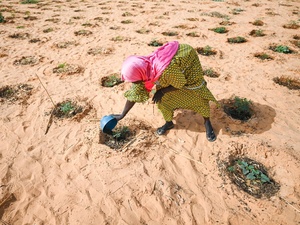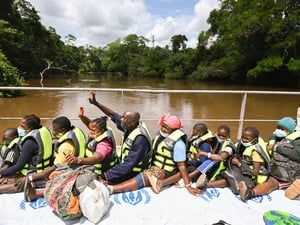Guinea: influx from Liberia
Guinea: influx from Liberia
Some 4,000 Liberian refugees have arrived this week in Guinea from Liberia's strife-torn Gbarnga region. The new arrivals have been registered in Guinea's Yomou Prefecture since the beginning of the week and the transfer of the refugees to a new transit centre, at Nonah, is scheduled to begin today.
Although obviously exhausted and traumatised by their ordeal, the new arrivals are generally in satisfactory health condition. Many arrive with no belongings, however. After being registered, they receive WFP emergency food rations (high protein biscuits and hot meals).
Although agreement in principle has been given for the establishment of a new site for up to 13,500 refugees at Lainé, about 1½ hours drive from from the southern Guinea town of Nzérékoré, it will still be at least a month before the first transit shelters are ready and two months before the establishment of the camp. UNHCR's partner, GTZ, has started erecting additional tents in Nonah transit centre, where the refugees from Gbarnga will stay until the new site at Lainé is ready. Water and sanitation systems are also being extended.
According to the newly arrived refugees, there could be another 6,000 to 10,000 Liberians heading to the border from the Gbarnga area, which has been the scene of new fighting between government and rebel forces in recent weeks.
In addition to the 4,000 from Gbarnga, about 720 Liberians have arrived in Tekoulo, between Macenta and Guéckédou (west of Nzérékoré). They are from Liberia's Lofa County, which has been a steady source of refugees for several months. They are being transferred to Kouankan camp, where all the refugees from Lofa are hosted. Kounakan is home to 20,000 Liberian refugees, including 6,500 "new arrivals" since March. It was initially meant for 13,500 refugees, but an extension had to be built in March as an emergency measure as the influx from Liberia intensified in the first months of the year.
In all, Guinea hosts an estimated 73,000 Liberian refugees, of whom 26,000 are in camps. The others are in urban areas or villages.







